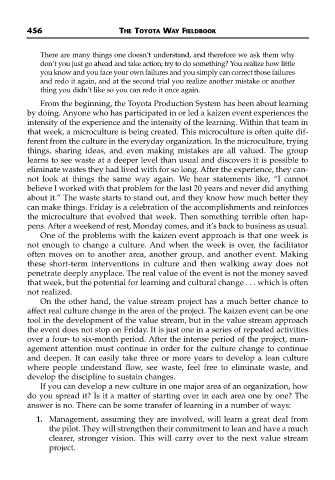Page 488 - The Toyota Way Fieldbook
P. 488
456 THE TOYOTA WAY FIELDBOOK
There are many things one doesn’t understand, and therefore we ask them why
don’t you just go ahead and take action; try to do something? You realize how little
you know and you face your own failures and you simply can correct those failures
and redo it again, and at the second trial you realize another mistake or another
thing you didn’t like so you can redo it once again.
From the beginning, the Toyota Production System has been about learning
by doing. Anyone who has participated in or led a kaizen event experiences the
intensity of the experience and the intensity of the learning. Within that team in
that week, a microculture is being created. This microculture is often quite dif-
ferent from the culture in the everyday organization. In the microculture, trying
things, sharing ideas, and even making mistakes are all valued. The group
learns to see waste at a deeper level than usual and discovers it is possible to
eliminate wastes they had lived with for so long. After the experience, they can-
not look at things the same way again. We hear statements like, “I cannot
believe I worked with that problem for the last 20 years and never did anything
about it.” The waste starts to stand out, and they know how much better they
can make things. Friday is a celebration of the accomplishments and reinforces
the microculture that evolved that week. Then something terrible often hap-
pens. After a weekend of rest, Monday comes, and it’s back to business as usual.
One of the problems with the kaizen event approach is that one week is
not enough to change a culture. And when the week is over, the facilitator
often moves on to another area, another group, and another event. Making
these short-term interventions in culture and then walking away does not
penetrate deeply anyplace. The real value of the event is not the money saved
that week, but the potential for learning and cultural change . . . which is often
not realized.
On the other hand, the value stream project has a much better chance to
affect real culture change in the area of the project. The kaizen event can be one
tool in the development of the value stream, but in the value stream approach
the event does not stop on Friday. It is just one in a series of repeated activities
over a four- to six-month period. After the intense period of the project, man-
agement attention must continue in order for the culture change to continue
and deepen. It can easily take three or more years to develop a lean culture
where people understand flow, see waste, feel free to eliminate waste, and
develop the discipline to sustain changes.
If you can develop a new culture in one major area of an organization, how
do you spread it? Is it a matter of starting over in each area one by one? The
answer is no. There can be some transfer of learning in a number of ways:
1. Management, assuming they are involved, will learn a great deal from
the pilot. They will strengthen their commitment to lean and have a much
clearer, stronger vision. This will carry over to the next value stream
project.

